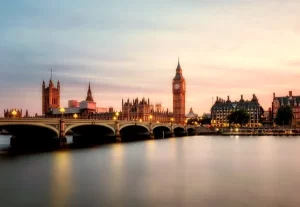Europe, renowned for its rich history, breathtaking landscapes, and diverse cultures, has always been a magnet for travelers worldwide. This article will explore the Cheapest European Destination Tips with the top 3 most popular attractions worldwide.
Cheapest European Destinations:
Porto
Porto beckons with its abundant charms, offering a serene escape from the bustling, museum-laden cities on Europe’s map. Here, visitors can unwind amidst a laid-back atmosphere while immersing themselves in many experiences. Wander across the iconic Dom Luís I Bridge for breathtaking vistas of the Rio Douro, bask in the coastal beauty along the city’s western shores, and soak in the vibrant ambiance of the UNESCO World Heritage Ribeira District.
For those with a penchant for indulgence, embark on a leisurely journey through Vila Nova de Gaia, where the finest port wines await at the renowned wine lodges. History buffs can explore the past at landmarks such as the Porto Cathedral, São Bento Railway Station, and Stock Exchange Palace. At the same time, art enthusiasts can marvel at masterpieces housed within the Museu Nacional de Soares dos Reis or the contemporary art museum of the Serralves Foundation. In Porto, every corner is infused with culture, history, and artistic inspiration, promising an enriching experience for every traveler.
Optimal Times for Visiting
The ideal time to visit Porto is typically from May to September when the weather is sunny and warm. Porto enjoys a moderate climate overall, with warm but comfortable summertime temperatures complemented by refreshing breezes and nearby beaches. Fall brings cooler temperatures and occasional drizzles, while winter is characterized by more frequent rain. Springtime in Porto also experiences some showers, although fewer than in winter, along with moderate temperatures.
The Cheapest European Destination Tips: Porto
Consider Investing in a Porto Card: With free or discounted admissions to select museums, restaurant discounts, and unlimited public transportation access, the Porto Card offers excellent value. Prices range from 13 to 33 euros, depending on duration and transportation coverage.
Take Advantage of Sunday Sightseeing: Several museums, including the Serralves Foundation and the Museu Nacional de Soares dos Reis, offer free entry on Sunday mornings and early afternoons. Plan your sightseeing accordingly to save money.
Hunt for Bargains: Explore Porto’s tourism board website for deals on accommodations, dining options, city tours, and more.
Cultural Practices and Traditions
Porto has earned renown for its wine production, particularly its sweet port wine crafted in the challenging yet unique landscape of the Douro Valley region. Here, the traditional harvest process is enriched by adding grape brandy during fermentation, followed by aging in casks, resulting in the signature sweet red port, often enjoyed as a dessert or paired with one.
Beyond its viticultural heritage, Porto is thriving as a tourist destination, boasting modern museums alongside its UNESCO World Heritage-designated historic center. Cultural enthusiasts can delve into a rich tapestry of art, architecture, history, and religious sites. At the same time, leisure seekers can indulge in many on-land and sea activities such as biking, boating, and swimming.
The people of Porto exemplify warmth and hospitality, greeting locals and visitors alike with hearty expressions like bom dia, boa tarde, or boa noite (good morning, good afternoon, or good evening). Portuguese is the predominant language, with essential phrases like por favor (please), Obrigado (thank you), and de nada (you’re welcome) being useful for travelers. While English is less commonly spoken than in Lisbon, learning some Portuguese phrases can enhance your experience.
The official currency is the euro, and exchange rates fluctuate, so it’s advisable to check before your trip. While major credit cards are widely accepted, some establishments, particularly smaller cafes or restaurants, may prefer cash. Tipping customs typically involve 5% to 10% at restaurants and around 10% or rounding to the nearest 5 euros for taxi rides.
Safety
Porto boasts a relatively low crime rate, making it a generally safe city for visitors. Nonetheless, it’s advisable to remain vigilant, particularly if traveling alone. Pickpocketing can occur in tourist-heavy areas and on public transport, so keeping a close eye on your belongings is wise. Exercise caution, especially after dark, and avoid wandering through alleys, which may attract homeless individuals or specific groups.

Prague
As a thriving metropolis, Prague has become a magnet for tourists, drawn not only by its picturesque cityscape but also by its storied past. Dating back to around A.D. 870, Prague has weathered countless challenges, from invasions to fires and floods, yet its resilience only adds to its allure. Today, the city’s historic churches, winding streets, majestic castle atop the hill, and iconic bridges create an enchanting urban landscape akin to a fairy tale setting.
Once a hidden gem, Prague shines brightly on the travel map, offering remarkable experiences at affordable prices. The city remains a treasure trove for savvy travelers, with top attractions like the Charles Bridge and Prague Castle offering free admission and hotels with budget-friendly accommodations. However, this era of bargain hunting may not last forever, so seize the opportunity while it lasts.
Optimal Times for Visiting
The optimal times to explore Prague are spring and early fall, characterized by mild weather and fewer crowds. While the summer brings warmer temperatures, they also attract more tourists, increasing hotel prices. In contrast, spring and early fall boast clear skies and temperatures ranging from the mid-50s to upper 60s, coupled with more affordable accommodations. Prague also exudes charm during the festive Christmas season, although visitors should be prepared for snowfall and colder temperatures, with highs typically not exceeding the mid-30s.
The Cheapest European Destination Tips: Prague
Opt for Off-Peak Seasons: With warm weather attracting crowds and escalating hotel rates, consider visiting Prague during the cooler months to avoid the tourist rush and save on accommodation costs.
Maximize Complimentary Breakfasts: Many hotels in Prague offer complimentary breakfasts, which can help you start your day right while saving on dining expenses. Prioritize hotels with this option when making reservations.
Avoid Taxis: Due to concerns about overcharging and dishonesty, it’s advisable to avoid taxis in Prague. Instead, rely on the city’s efficient public transportation system to get around.
Take Advantage of Guided Tours: Explore Prague’s hidden gems and local insights by joining free guided tours. Discover the city’s best tours to enhance your experience while saving money.
Cultural Practices and Traditions
Czechia, established in 1993 after the Cold War, operates as a Parliamentary Republic. However, Prague and the Czech state have long been significant business, government, and commerce hubs. Despite being known for their formality and reserve compared to some European counterparts, Czech citizens are also recognized for their friendliness. In many Prague bars and restaurants, groups can share tables, fostering a communal atmosphere.
An etiquette tip: placing your fork and knife on your plate signals to the waiter that you’re finished.
The official currency is the koruna, widely accepted by major credit cards in Prague. Given the fluctuating koruna to U.S. dollar exchange rate, checking the current rate beforehand is advisable. Tipping 10 to 15 percent for good service is customary, but remember to hand it directly to your server.
Like in many European cities, attempting a few phrases in the local language can endear travelers to locals. A phrasebook can be invaluable, with expressions such as “thank you” (Dekuji), “excuse me” (S dovolením), and “do you speak English?” (Mluvíte anglicky?) being particularly useful.
Safety
Prague is widely regarded as a safe city, particularly given its scale. However, it’s essential to remain vigilant against pickpockets, particularly in tourist-packed areas such as the Astronomical Clock and Charles Bridge. Exercise caution when using public transportation, as pickpockets may target commuters. Additionally, be mindful of potential overcharging by some taxi drivers. To mitigate this risk, consider calling for a taxi or heading to authorized taxi stands identifiable by red and yellow signs.
Valencia
Valencia captivates the senses and the purse strings with its delightful scenery and affordability. The verdant shades of the Jardí del Túria beautifully complement the glistening golden sands and azure waves caressing its beaches. The vibrant hue of its oranges mirrors their delectable flavor.
Critics who claim this Spanish coastal gem lacks charm likely haven’t strolled beneath the citrus-laden trees, where blossoms scatter over cobblestone streets or savored the melodic Valencian dialect amid the bustling stalls of Mercado Central. Despite lingering in the shadows of larger cities for years, Valencia now presents a fusion of Madrid’s historical allure and Barcelona’s contemporary vibrancy, all at a more budget-friendly price.
Optimal Times for Visiting
The optimal times to experience Valencia’s charm are during April-May and September-October, offering a perfect balance of warm weather without the overwhelming crowds. Valencia enjoys a typical Mediterranean climate, featuring consistently pleasant conditions throughout the year. However, the scorching heat of August prompts many locals to close up shop and seek cooler climates further north.
Enjoying around 300 days of sunshine each year, Valencia’s temperatures range from around 60 degrees Fahrenheit in cooler months to 85 degrees Fahrenheit during peak summer. Be prepared for occasional blistering days, particularly in July and August, during soaring temperatures of 95-100 degrees Fahrenheit. Winters are comfortably mild, ranging from the mid-40s to mid-60s Fahrenheit, and offer a quieter, less tourist-filled atmosphere. Nevertheless, some attractions may have reduced hours during this season.
The Cheapest European Destination Tips: Valencia
Explore Valencia during the offseason, typically from November to January, when hotel rates drop and crowds thin out, although some attractions may operate on winter schedules.
Indulge in culinary delights at Mercado Central, where numerous restaurants offer prix fixe menus and delightful tapas for approximately 13 to 15 euros (roughly $14 to $16) per person.
Opt for a Valencia Tourist Card, which grants unlimited access to the city’s public transportation system and complimentary entry to municipal museums and landmarks. Additionally, it provides discounts at major museums, attractions, and shops. Available in one- to three-day options, these cards can be purchased at most tourist information desks, airport vending machines, and online.

Cultural Practices and Traditions
Valencia is the capital of the province and the autonomous community of the same name. Valencia officially recognizes two languages: Spanish and the Valencian dialect of Catalan. It’s worth noting that Valencians often refer to Spanish as Castellano, as they consider Valencian to be a distinct language rather than a dialect, even though both are forms of Spanish.
While Spanish predominates, the local government uses Valencian. This can confuse visitors, as one or the other language (and sometimes both) may appear on street signs. The city’s bilingual residents won’t expect travelers outside the province to know Valencian.
In Valencia, the tradition of the siesta is observed, leading to the closure of many businesses, including shops and some museums, during part of the afternoon, usually from around 1:30 or 2 p.m. until 4:30 or 5 p.m. The exceptions to this practice are restaurants, which may operate during the traditional siesta time but close for a couple of hours before reopening for dinner service around 8 or 9 p.m. (the standard starting time for the meal). Shopping malls and supermarkets tend to stay open for siesta. Many businesses (other than museums, cinemas, bars, and restaurants) do not open on Sundays or, if they do, will have shorter hours.
Valencia operates with the euro (EUR) as its official currency. Since the euro to U.S. dollar exchange rate fluctuates often, check the current rate. The majority of restaurants and shops readily accept major credit cards. As in the rest of Spain, tipping is rare in Valencia.
Conclusion:
Traveling around Europe can be affordable. By venturing off the beaten path and steering clear of popular tourist hubs like London and Paris, you can stretch your travel budget further and uncover hidden gems at affordable prices. U.S. News considered various factors, including average hotel rates, flight bargains, available vacation bundles, budget-friendly attractions, and overall ease of accessibility, along with user feedback, to compile this top budget-friendly European getaways.
Make your journey premium with Ita-Airways
ITA Airways, the flag carrier of Italy, operates as a modern and innovative airline offering domestic and international flights. Committed to delivering exceptional service, sustainability, and connectivity. The airline’s fleet comprises state-of-the-art aircraft designed for efficiency and passenger comfort, with routes connecting major cities across Europe, North America, Asia, and beyond. Its website, ita-airways.com, serves as a comprehensive platform for booking flights, managing reservations, and accessing exclusive deals.




